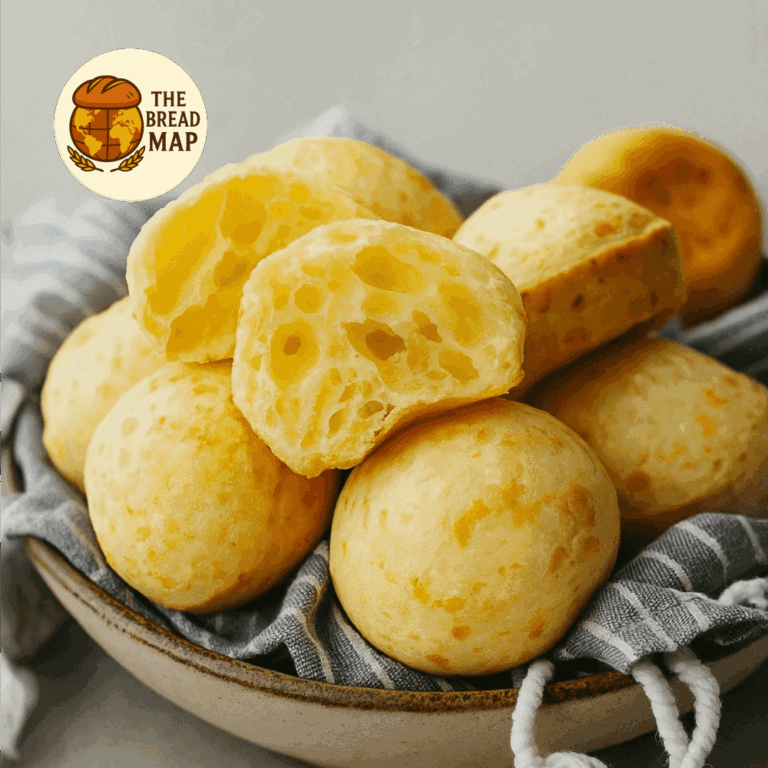
Ah, pão de queijo! Whether wafting from a Brazilian padaria at dawn or cradled in a street vendor’s basket, these crispy-on-the-outside, chewy-on-the-inside cheese puffs are instant invitations to slow down and savor. What makes pão de queijo unforgettable isn’t just its compelling blend of flavors and textures—it’s also the sense of comfort and community that comes bundled with every golden bite. Let’s journey together into the story of this beloved Brazilian delicacy.
Historical Background
Pão de queijo’s origin traces back to the 18th century in the picturesque region of Minas Gerais, at a time when wheat flour was scarce in Brazil’s colonial interior. To bake bread, inventive cooks turned to locally abundant cassava (tapioca) root, a staple among indigenous peoples. When dairy farms began to flourish nearby, local cheese found its way into the batter. This ingenious fusion of flavors and necessity gave birth to the first forms of cheese bread—foods that families have enjoyed for generations.
Region of Origin
While you’ll find pão de queijo throughout Brazil nowadays—in urban cafes, airports, and community gatherings—its spiritual home remains Minas Gerais. This inland, mountainous state is famous for its rich agricultural traditions, warm hospitality, and a culinary identity deeply rooted in hearty, rustic fare. It’s here that pão de queijo is most fiercely celebrated, with artisanal bakeries and home cooks constantly perfecting their personal recipes and rituals.
Ingredients and Preparation
One of the greatest charms of pão de queijo is its simplicity:
- Tapioca flour (polvilho): Unlike wheat flour, this comes from the cassava root, giving the bread its signature chewy texture and gluten-free distinction.
- Cheese: Traditionally, Minas cheese is prized, but Parmesan or mozzarella can fill in. The cheese should be flavorful but not too moist.
- Eggs: They lend richness and help bind the dough.
- Milk: Adds moisture and a subtle sweetness.
- Oil or butter: Provides tenderness and a golden crust.
- Salt: Essential for balance.
The magic happens when these ingredients are combined: Milk and oil are warmed, then poured over the tapioca flour—a crucial step for that pillowy interior. Cheese and eggs are kneaded in, resulting in a sticky, elastic dough. Rolled into bite-sized balls and popped into a hot oven, they emerge with a gentle crackle, puffed and glistening, their fragrance irresistible.
Cultural Importance
For Brazilians, pão de queijo is not just a snack; it’s a symbol of home, nostalgia, and shared moments. Walk into any Brazilian household or café, and you’ll find friends dipping them into coffee, kids delighted at after-school merenda, families marking Sunday mornings together.
They’re a fixture at:
- Breakfast tables, often paired with strong coffee.
- Social gatherings, bridging generations and backgrounds.
- Festivals and markets, where bakers offer their own secret blends.
Even beyond Brazil’s borders, pão de queijo is embraced by gluten-free communities and adventurous food lovers alike. Yet, for many, the true heart of cheese bread beats strongest in its homeland, where every bite is a tribute to resourcefulness, hospitality, and joy.
So, would I try pão de queijo? Absolutely—and I urge you to, too! Brazil’s beloved cheesy delight is much more than bread: it’s a warm hug in food form, waiting to transport you straight to the heart of Minas Gerais.
Leave a Reply